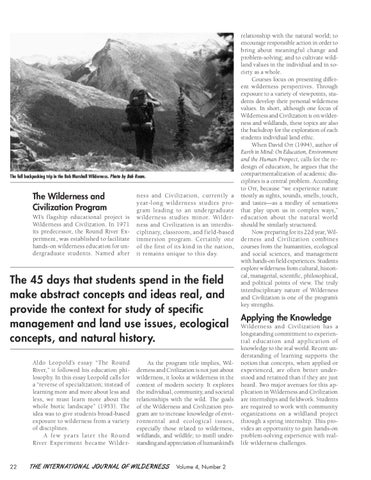The fall backpacking trip in the Bob Marshall Wilderness. Photo by Bob Ream.
The Wilderness and Civilization Program WI’s flagship educational project is Wilderness and Civilization. In 1971 its predecessor, the Round River Experiment, was established to facilitate hands-on wilderness education for undergraduate students. Named after
ness and Civilization, currently a year-long wilderness studies program leading to an undergraduate wilderness studies minor. Wilderness and Civilization is an interdisciplinary, classroom, and field-based immersion program. Certainly one of the first of its kind in the nation, it remains unique to this day.
The 45 days that students spend in the field make abstract concepts and ideas real, and provide the context for study of specific management and land use issues, ecological concepts, and natural history. Aldo Leopold’s essay “The Round River,” it followed his education philosophy. In this essay Leopold calls for a “reverse of specialization; instead of learning more and more about less and less, we must learn more about the whole biotic landscape” (1953). The idea was to give students broad-based exposure to wilderness from a variety of disciplines. A few years later the Round River Experiment became Wilder-
22
As the program title implies, Wilderness and Civilization is not just about wilderness, it looks at wilderness in the context of modern society. It explores the individual, community, and societal relationships with the wild. The goals of the Wilderness and Civilization program are to increase knowledge of environmental and ecological issues, especially those related to wilderness, wildlands, and wildlife; to instill understanding and appreciation of humankind’s
THE IN TERNA TI ONAL J OU RNAL OF WILDERNESS
Volume 4, Number 2
relationship with the natural world; to encourage responsible action in order to bring about meaningful change and problem-solving; and to cultivate wildland values in the individual and in society as a whole. Courses focus on presenting different wilderness perspectives. Through exposure to a variety of viewpoints, students develop their personal wilderness values. In short, although one focus of Wilderness and Civilization is on wilderness and wildlands, these topics are also the backdrop for the exploration of each students individual land ethic. When David Orr (1994), author of Earth in Mind: On Education, Environment and the Human Prospect, calls for the redesign of education, he argues that the compartmentalization of academic disciplines is a central problem. According to Orr, because “we experience nature mostly as sights, sounds, smells, touch, and tastes—as a medley of sensations that play upon us in complex ways,” education about the natural world should be similarly structured. Now preparing for its 22d year, Wilderness and Civilization combines courses from the humanities, ecological and social sciences, and management with hands-on field experiences. Students explore wilderness from cultural, historical, managerial, scientific, philosophical, and political points of view. The truly interdisciplinary nature of Wilderness and Civilization is one of the program’s key strengths.
Applying the Knowledge Wilderness and Civilization has a longstanding commitment to experiential education and application of knowledge to the real world. Recent understanding of learning supports the notion that concepts, when applied or experienced, are often better understood and retained than if they are just heard. Two major avenues for this application in Wilderness and Civilization are internships and fieldwork. Students are required to work with community organizations on a wildland project through a spring internship. This provides an opportunity to gain hands-on problem-solving experience with reallife wilderness challenges.
